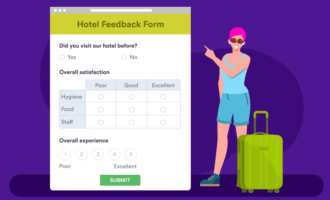The 10 best diversity and inclusion questions to ask questions
- Do you feel your perspective is well represented at the company?
- Does the organization celebrate ideas and perspectives from diverse groups of people?
- Do you feel safe discussing diversity and inclusion initiatives at the organization?
- Does the organization prioritize diversity but not inclusion?
- Does the organization discuss diversity and inclusion programs with all employees?
- How have diversity and inclusion programs impacted your performance on a personal level?
- Does the organization educate employees about diversity and inclusion?
- How have diversity and inclusion initiatives changed your day-to-day outlook at work?
- How can the company improve its diversity and inclusion practices?
- What do you like about the company’s diversity and inclusion programs?
The words diversity and inclusion — which often appear together in the shortened form of D&I — are more than just buzzwords. They’re part of a series of policies and programs that help foster an equitable culture in the workplace, ensuring that companies respect the unique perspectives and needs of all their employees.
Through diversity and inclusion initiatives, organizations can cultivate a deep sense of trust and commitment from their team members, leading to better performance and higher employee satisfaction.
An important part of diversity and inclusion programs is gathering feedback from company employees and leaders to understand where the organization is succeeding in its D&I efforts and where it can improve. In this article, we cover why diversity and inclusion is important in the workplace, what types of diversity and inclusion questions to ask in your surveys, and how to create a D&I survey of your own.
The importance of diversity and inclusion in the workplace
Before we can explain the significance of diversity and inclusion, we need to have a clear understanding of what the two words mean. People often use these terms interchangeably; however, while they are interconnected, they don’t mean the same thing.
Diversity in a workplace setting refers to the variety of different identities and attributes represented in a group, such as the employees or the executive team. Ideally, the workplace should include people who have varying racial, social, ethnic, and religious backgrounds and represent different genders, sexual orientations, abilities, and more. After all, a variety of perspectives can create a stronger workplace.
Asking questions related to diversity can help organizations determine whether certain groups of people are underrepresented or not represented at all in the workplace.
Inclusion, which is related to diversity, refers to how well the organization values the perspectives of different workplace groups. For example, if men, women, and nonbinary individuals equally make up the workplace but men make the majority of leadership decisions, then the workplace isn’t really inclusive because the organization isn’t taking everyone’s perspectives into consideration.
Having diversity and inclusion programs and policies in an organization is important because it shows all employees that their contributions are valued. D&I initiatives lead to higher employee satisfaction, employee retention, and revenue growth.
When employees feel their organization values them, they’re more likely to be creative and innovative and to take pride in their association with the company. Employees who feel the organization disrespects them, on the other hand, are more likely to leave for another position.
Different types of diversity and inclusion surveys
Developing an effective diversity and inclusion program requires gathering feedback from employees and leaders. Gathering this data helps organizational leaders understand how the company’s diversity and inclusion initiatives are working — as well as where they need improvement. It’s essential to create key performance indicators (KPIs) for the program so the organization can measure and track the success of these programs.
“When most people think of diversity and inclusion surveys, they think of those that center around the ’protected characteristics’ that enjoy legal protection: race, sex, gender identity, sexual orientation, religion, disability, and cultural background,” says Richard J. Brandenstein, attorney and partner at FBR Law, a firm specializing in workers’ compensation and Social Security disability benefits.
“However,” he says, “it’s worth considering that D&I surveys can and should be used to ascertain the makeup of your workforce as it pertains to other characteristics, including education level, socioeconomic background, and mental health, amongst others. For example, you may wish to develop a survey to find out if you are doing enough to promote talent regardless of economic background and education level, or whether you are subconsciously favoring those from more affluent backgrounds and with more highly regarded qualifications, despite performance.”
There are different types of D&I surveys that can help your organization make better diversity and inclusion decisions in the future. These include
- Diversity surveys: These surveys help the organization evaluate the diversity of their workforce and determine which groups are currently represented at each level of the organization.
- Inclusion and belonging surveys: These surveys enable the organization to understand employees’ perceptions of belonging and inclusion within the company and whether employees feel all groups are well represented at a decision-making level.
- Mentorship and advocacy surveys: This type of survey shows organizations whether employees have support and guidance within and outside the company and whether they feel these programs are valuable to each of them as individuals and as part of a group.
- Partner and vendor diversity surveys: Hiring diverse employees is only a small part of a diversity and inclusion initiative. Partner and vendor diversity surveys help organizations determine whether they’re working with other organizations that are diverse and that support D&I as well.
- Live polls: While most surveys are anonymous and geared toward individuals, these surveys are meant for groups to complete in public, such as at a town hall meeting, with the results displayed live. These surveys can be used to get immediate feedback from an audience during a presentation or panel discussion.
Diversity and inclusion questions to ask employees
“Of course, your D&I surveys need to ask the basic demographic questions regarding the protected characteristics as mentioned above,” says Brandenstein. “However, a D&I survey isn’t just an opportunity as an employer to ascertain the diversity of your workforce; it’s also your chance to gauge how your employees feel about your D&I efforts. That’s why D&I surveys should also give respondents an opportunity to rate the diversity and inclusion efforts of the company across a wide range of statements.”
What types of questions should your organization be asking? It depends on the key performance indicators you want to track, the diversity and inclusion goals you want to achieve, and how mature your organization’s diversity and inclusion programs are. Here are some options.
Diversity and inclusion questions for all employees
- Do you feel your perspective is well represented at the company?
- Does the organization celebrate ideas and perspectives from diverse groups of people?
- Do you feel safe discussing diversity and inclusion initiatives at the organization?
- Does the organization prioritize diversity but not inclusion?
- Does the organization discuss diversity and inclusion programs with all employees?
- How have diversity and inclusion programs impacted your performance on a personal level?
- Does the organization educate employees about diversity and inclusion?
- How have diversity and inclusion initiatives changed your day-to-day outlook at work?
- How can the company improve its diversity and inclusion practices?
- What do you like about the company’s diversity and inclusion programs?
Diversity and inclusion questions for leadership and executive team members
- How diverse is your executive team?
- Do you have a program to hire candidates from under-represented groups?
- Have the company’s diversity and inclusion programs changed how you lead your team?
- What barriers do you think the organization faces when it comes to diversity and inclusion programs?
- Do your employees ever bring up diversity and inclusion discussions with you?
- What are the consequences of not taking diversity and inclusion programs seriously within an organization?
- How advanced is the organization when it comes to diversity and inclusion?
- What do you do to foster a culture of inclusion with your team?
- How have diversity and inclusion initiatives impacted your leadership style?
- What do you like most about the company’s diversity and inclusion programs?
Diversity and inclusion survey best practices
When writing your organization’s diversity and inclusion surveys, be sure to consider these best practices for the best results.
- Keep it interesting. Use a combination of closed-ended and open-ended question formats.
- Don’t force it. Make diversity and inclusion surveys optional so employees can choose what information they want to provide.
- Provide safety. Keep diversity and inclusion surveys anonymous, giving employees more freedom to be honest without fear of negative repercussions.
- Be transparent. Make employees aware of what your reasons are for conducting these surveys, what KPIs you’re measuring, and how you’ll use their answers.
- Say thanks. Let employees know you value their feedback and that you hope to use their insights to make positive changes within the workplace.
- Act on feedback. Surveys are moot if the organization doesn’t make changes based on the results. Be sure to have a plan in place to take action.
Jotform: The best way to create diversity and inclusion question surveys
Ready to develop your own diversity and inclusion questions? If your organization is gearing up to do a D&I survey, consider using Jotform to create and administer it. Jotform offers a number of human resources survey templates you can use as a jumping-off point, in addition to surveys specifically about workplace diversity.
Each Jotform template is fully customizable, so it’s easy for your organization to change the text fields, structure, background, colors, and more. The end result is a survey that meets your specific needs and gives you better insight into the D&I efforts at your organization. You can automatically collect, organize, and analyze all survey data in Jotform Tables.
Says Brandenstein, “This feedback can be used to improve the employee experience and will benefit everyone — current and future employees, as well as management and owners — as happy and comfortable employees are the most productive.”






































































































Send Comment: